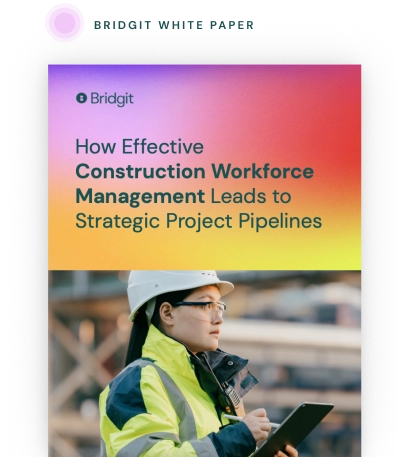Table of Contents
One of the challenges in construction has nothing to do with building, at least not directly; it’s with appealing to the next generation of construction workers, mainly Millennials and Gen Z. At this point, everyone in the industry is aware of the persistent labor shortages and cloudy economic outlook, but the aging workforce is a deep problem that can cause a lot of collateral damage.
In some ways, construction is a microcosm of baby boomers retiring on a societal scale; there simply aren’t enough people to replace the mass of people slated to retire in the coming decade. According to the Bureau of Statistics, the average age of a construction worker is 42.5 years old. Most construction workers retire by age 61, and they have a drop off in productive work at about 51.
Additionally, the industry saw the number of construction workers aged 55 and up increase from just under 17 percent in 2011 to almost 22 percent in 2018. There was also a decline in workers aged 25-54 (prime working age), going from 75 percent to 69 percent. At the same time, the industry is struggling to attract younger workers as only 9 percent of the industry is 25 or under, compared to 12.3 percent of the rest of the labor force.
This tells us that in about a decade, there may be a significant drop in the productive ability of the construction workforce. This means delays, cost overruns, and projects not getting off the ground. This isn’t a good sign, especially as the money from the IIJA is supposed to be used for revamping crumbling infrastructure throughout the country. Add the difficulty of existing labor shortages, making the situation seem dire.
As we’ve said before, these stressors on the industry open up opportunities to make better business decisions and, in the case of marketing to younger generations, re-envision how construction is thought of and talked about in general.
In this article, we’ll outline how you can appeal to the next generation of construction workers.

Use your workforce data to create a competitive advantage
Download our white paper to see how effective workforce planning can help stay ahead of labor demands and create a strategic project pipeline.
Technology and flexibility
We know that the construction industry gets a bad rap for being “outdated,” “old-school,” and “old-fashioned.” While this isn’t necessarily the industry’s fault, creating technology that suits the complexity of projects is extremely difficult. It’s imperative you understand that technology is natural to younger generations.
This applies both on job sites and in the office. Millennials and Gen Z want to use the latest technology, not only because they’re curious about it but because the apparent complexities of the technology aren’t that complex for them; they’re already technologically inclined and extremely literate.
The benefit of this is manyfold; by updating your technology, you can simultaneously appeal to younger people while recruiting people who find it easy to learn and use. Your processes will also become more efficient as most of these tools are designed to capture data and help make good-quality decision-making easier over time.
Another benefit of upgrading your technology is you’ll be more likely to account for one of the biggest values for younger generations: flexibility. According to a survey conducted by Workforce Institute, Gen Z workers wouldn’t tolerate these three things:
- 35% say they wouldn’t tolerate being forced to work when they don’t want to.
- 34% say they wouldn’t tolerate not being able to use vacation days when they want to.
- 33% say they wouldn’t tolerate an employer who gave them no flexibility over their work schedule.
Another interesting note is that 44 percent of respondents said they’d prefer to have face-to-face interaction with coworkers.
What does this tell us? For future office workers in construction, flexibility is key. Large industries like tech have already embraced this flexibility, and with the communication tools at our disposal, it’s possible for the construction industry to do it, too.
Keep the job hoppers grounded
One way Baby Boomers and Generation X differ from younger generations is their time with one job. For younger generations, it’s common to “job hop”, meaning workers stay in a place for one or two years and find a new job. The benefits of this are higher salaries and faster promotions. Recently, this job-hopping trend has started to backfire as employers want people long-term, not someone who’ll come in and leave as soon as the next opportunity presents itself.
This responsibility falls on the employer, though. It’s up to them to create incentives and a path for career advancement that keeps people invested in the company long-term. The construction industry is no exception to this. One of the industry’s advantages over others is its huge scope, and because of the scope of work and complexity, there’s a variety of roles people can learn and grow into.
Recognizing this advantage and creating the necessary structures for employee development and networking will go a long way to attracting and retaining talent from other industries. Ryan Companies recognizes this and is taking the time to build the internal infrastructure to help people learn and develop in various ways. It’s better to start now.
A new vision for construction
One thing Millennials and Gen Z have expressed is the desire for their work to have an impact on the world. Other industries have convinced younger workers that they’ll have an impact working in them because they’re making people’s lives easier and more efficient or they’re protecting the planet.
Construction has a unique message it can bring to this that goes beyond “having a good job that pays well.” Being in construction means participating in one of the oldest and most important human activities, not just as an economic node but as a builder and preserver of civilization.
If you work in construction, you’ll directly participate in the monuments that outlast us. TikToks won’t last, and selling ads to squeeze an extra cent out of consumers won’t last. Stadiums last, skyscrapers last, and homes last. Construction may be the only industry selling the closest thing people have to immortality.
One of the few artifacts we have to tell us the stories of our past is through the structures people create, which leave us with wonder and stimulate our imagination. Additionally, this industry creates places where people work, study, live, worship, and entertain. You’re creating the places that house the stories of our lives. Excuse us for getting philosophical, but construction isn’t simply “work,” and it shouldn’t be marketed that way. It’s the link between the past, present, and future. If that isn’t impactful… nothing is.


